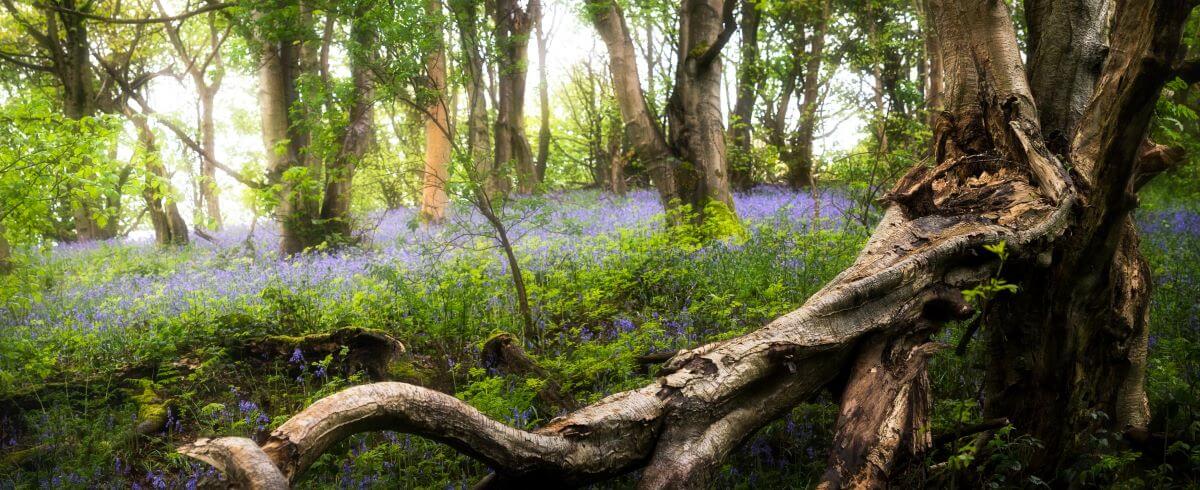J.R.R Tolkien, who spent time walking The Malverns with friend C. S. Lewis, was known to have a love of trees and forests – famously bringing them to life as the wise and ancient ‘Ents’ in The Lord of the Rings trilogy. Indeed, the destruction of forests and their importance to wellbeing is somewhat of a theme in his writing; often describing trees and forests in great detail and giving them a sense of being living, feeling entities.
Many people find peace and wellbeing in wooded areas, and the effectiveness of seeking woodland to improve the mood is backed up by science. The Mental Health Foundation conducted a study which showed that 65% of people experienced positive emotions like calmness and wonder when connecting with nature. The study also showed that it was not just time spent in nature that made a difference, but the quality of that time. This is where the concept of shinrin-yoku, forest bathing, comes in. Popularised by the Japanese government as a science backed way to improve health and reduce the stress caused by technology, the workplace and city living, forest bathing involves using all five senses to connect with your natural surroundings. The basic concept calls for unstructured, undistracted time spent in the forest, using the senses to experience it fully, as a child might; lying on the grass, picking up fallen leaves or interesting rocks, noticing the different bark formations on trees.
Image credit: Jan Sedlacek, Digitlight Photography
Top Tips for Forest Bathing
- Find a suitable location, see our list below for some inspiration. Try to find a spot with plenty of trees and green foliage, far from built up areas or noisy roads. Don’t feel you need to walk far into the wilderness, listen to your body and level of fitness and go where you feel comfortable.
- Banish screens and other distractions, put your phone on silent and take your headphones off. The key to forest bathing is the use of all 5 senses to take in your surroundings, so reduce other distractions as far as possible.
- Use your senses. Take deep breaths noticing the smell and taste of the forest air, feel smooth grass tickling your hands, notice how the light falls to the forest floor and hear the cheeping of small birds or rustling of insects. Forest bathing should be a tactile and multi-sensory experience, but please make sure not to damage any part of the forest.
- Spend time. The longer and more often you spend in this activity, the better. Some recommend 2 -3 hours for a fully immersive experience but if you are new to the concept try a series of smaller sessions building up the length each time.
- Be practical and respect the forest. Leave no trace of your visit and be careful not to disturb plants and animals . Make sure to dress practically, including suitable shoes, as trails may be muddy and un-even . Always follow the Countryside Code to keep nature safe and accessible for all.
Locations in The Malverns
Park Wood – This area of ancient woodland located in West Malvern consists mostly of large old oak trees and some hazel. Traditional methods have been used to restore the flora and fauna of this woodland meaning it’s a flourishing spot with unusual plants, butterflies, dormice and deer.
Shrawley Woods – A special spot of woodland, managed by Forestry England, located just north of Holt Heath. Large mature trees, thick green forest and stepping stones over the brook. Expect a spectacular display of bluebells through late April and early May.
Ravenhill Nature Reserve – Wooded nature reserve to the northern end of the Malvern Hills AONB consisting of semi-natural ancient woodland. Currently open only for warden led guided walks so make sure to book in advance for a personalised forest experience. One for amphibian fans as the reserve is home to a fairly sizable population of toads – if you stay still and quiet for a while, perhaps you will be lucky enough to spot one.
Raggedstone Hill – Walks around the southern end of the Malvern Hills are more wooded and slightly quieter than the popular Beacon and British Camp routes. Raggedstone Hill, Chase End Hill and Whiteleaved Oak contain woodland including some very old oak trees, although sadly the famous Whiteleaved Oak tree burned down in 2020. Park at Hollybush and be prepared for a fairly steep walk if you would like to summit Raggedstone.
Crews Hill Wood – Ancient trees grow in this small but perfectly formed woodland. Crews Hill Wood is seven hectares of heaven with a great selection of tree species; oak, ash, beech, small-leaved lime, wild service, hornbeam, old yew trees, maple, hawthorn and hazel. This is a fairly dense, hidden woodland with limited surrounding views, ideal for full forest immersion.




